engine YAMAHA VMAX 2001 User Guide
[x] Cancel search | Manufacturer: YAMAHA, Model Year: 2001, Model line: VMAX, Model: YAMAHA VMAX 2001Pages: 110, PDF Size: 11.88 MB
Page 34 of 110

4-1
4
EAU01114
4-PRE-OPERATION CHECKSThe condition of a vehicle is the owner’s responsibility. Vital components can start to deteriorate quickly and unexpectedly,
even if the vehicle remains unused (for example, as a result of exposure to the elements). Any damage, fluid leakage or loss
of tire air pressure could have serious consequences. Therefore, it is very important, in addition to a thorough visual inspec-
tion, to check the following points before each ride.
EAU03328
Pre-operation check list
ITEM CHECKS PAGE
Front brake
• Check operation, free play, fluid level, and for fluid leakage.
• Fill with DOT 4 brake fluid if necessary.6-25–6-28
Rear brake6-25–6-28
Clutch• Check operation, fluid level, and for fluid leakage.
• Fill with DOT 4 brake fluid if necessary.6-24, 6-27
Throttle grip and housing• Check operation.
• Lubricate if necessary.6-21, 6-29
Engine oil• Check oil level.
• Add oil if necessary.6-9–6-12
Coolant• Check coolant level.
• Add coolant if necessary.6-14–6-18
Final gear oil• Check vehicle for leakage. 6-13
Wheels and tires• Check tire air pressure, for wear and damage. 6-21–6-24
Control cables• Check operation.
• Lubricate if necessary.6-28
Brake and shift pedal
shafts• Check operation.
• Lubricate if necessary.6-29
Brake and clutch lever
pivots• Check operation.
• Lubricate if necessary.6-30
Center and sidestand
pivots• Check operation.
• Lubricate if necessary.6-30
E_3lr.book Page 1 Wednesday, November 22, 2000 4:10 PM
Page 37 of 110
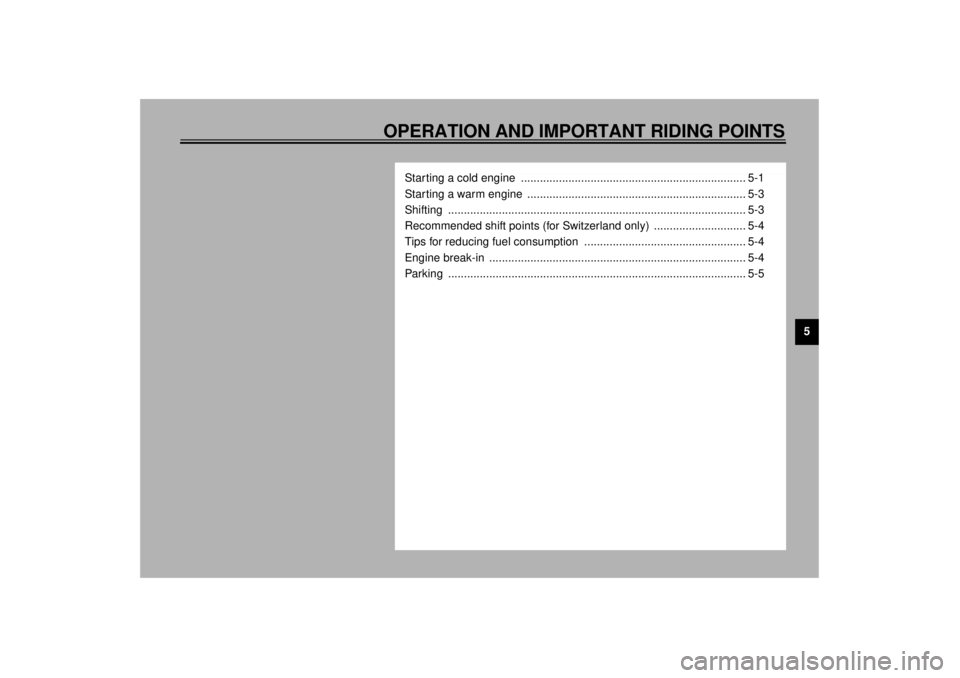
OPERATION AND IMPORTANT RIDING POINTS
5
Starting a cold engine ....................................................................... 5-1
Starting a warm engine ..................................................................... 5-3
Shifting .............................................................................................. 5-3
Recommended shift points (for Switzerland only) ............................. 5-4
Tips for reducing fuel consumption ................................................... 5-4
Engine break-in ................................................................................. 5-4
Parking .............................................................................................. 5-5
E_3lr.book Page 1 Wednesday, November 22, 2000 4:10 PM
Page 38 of 110
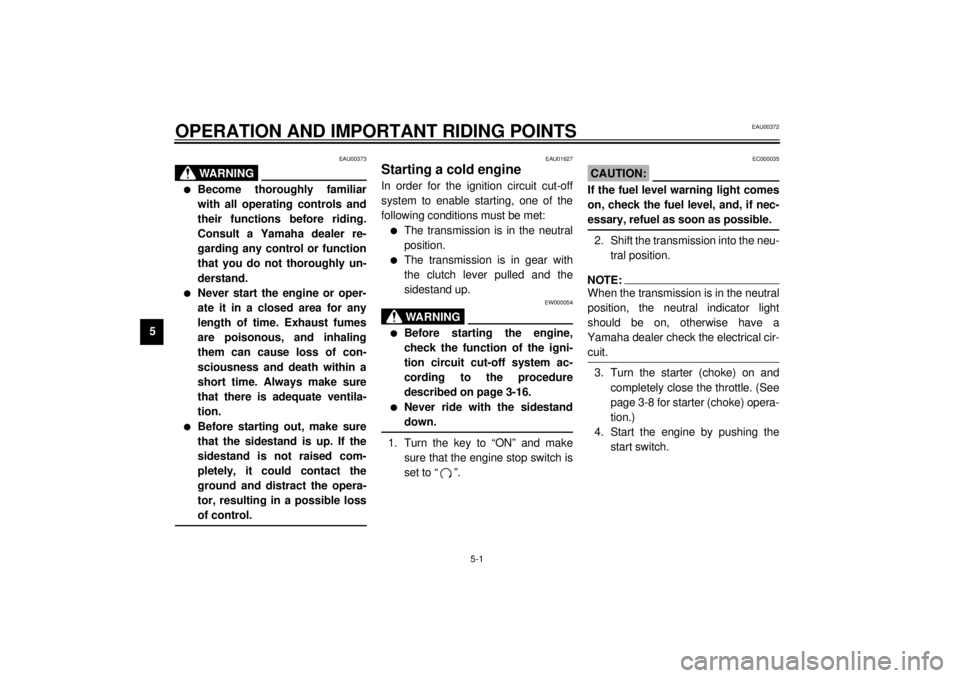
5-1
5
EAU00372
5-OPERATION AND IMPORTANT RIDING POINTS
EAU00373
WARNING
@ l
Become thoroughly familiar
with all operating controls and
their functions before riding.
Consult a Yamaha dealer re-
garding any control or function
that you do not thoroughly un-
derstand.
l
Never start the engine or oper-
ate it in a closed area for any
length of time. Exhaust fumes
are poisonous, and inhaling
them can cause loss of con-
sciousness and death within a
short time. Always make sure
that there is adequate ventila-
tion.
l
Before starting out, make sure
that the sidestand is up. If the
sidestand is not raised com-
pletely, it could contact the
ground and distract the opera-
tor, resulting in a possible loss
of control.
@
EAU01627
Starting a cold engine In order for the ignition circuit cut-off
system to enable starting, one of the
following conditions must be met:l
The transmission is in the neutral
position.
l
The transmission is in gear with
the clutch lever pulled and the
sidestand up.
EW000054
WARNING
@ l
Before starting the engine,
check the function of the igni-
tion circuit cut-off system ac-
cording to the procedure
described on page 3-16.
l
Never ride with the sidestand
down.
@1. Turn the key to “ON” and make
sure that the engine stop switch is
set to “ ”.
EC000035
CAUTION:@ If the fuel level warning light comes
on, check the fuel level, and, if nec-
essary, refuel as soon as possible. @2. Shift the transmission into the neu-
tral position.NOTE:@ When the transmission is in the neutral
position, the neutral indicator light
should be on, otherwise have a
Yamaha dealer check the electrical cir-
cuit. @3. Turn the starter (choke) on and
completely close the throttle. (See
page 3-8 for starter (choke) opera-
tion.)
4. Start the engine by pushing the
start switch.
E_3lr.book Page 1 Wednesday, November 22, 2000 4:10 PM
Page 39 of 110
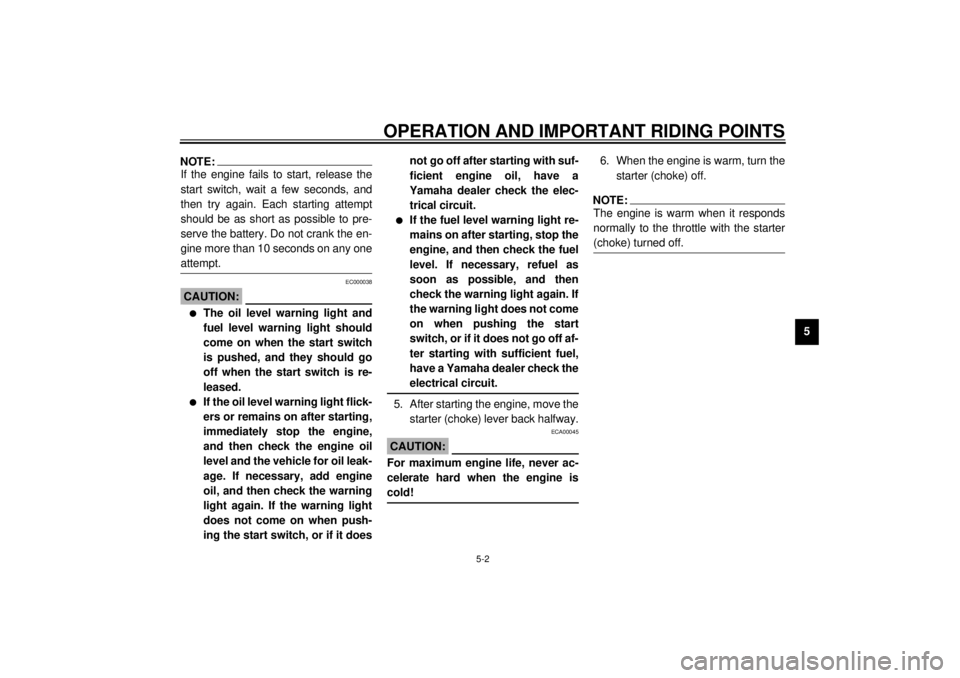
OPERATION AND IMPORTANT RIDING POINTS
5-2
5
NOTE:@ If the engine fails to start, release the
start switch, wait a few seconds, and
then try again. Each starting attempt
should be as short as possible to pre-
serve the battery. Do not crank the en-
gine more than 10 seconds on any one
attempt. @
EC000038
CAUTION:@ l
The oil level warning light and
fuel level warning light should
come on when the start switch
is pushed, and they should go
off when the start switch is re-
leased.
l
If the oil level warning light flick-
ers or remains on after starting,
immediately stop the engine,
and then check the engine oil
level and the vehicle for oil leak-
age. If necessary, add engine
oil, and then check the warning
light again. If the warning light
does not come on when push-
ing the start switch, or if it doesnot go off after starting with suf-
ficient engine oil, have a
Yamaha dealer check the elec-
trical circuit.
l
If the fuel level warning light re-
mains on after starting, stop the
engine, and then check the fuel
level. If necessary, refuel as
soon as possible, and then
check the warning light again. If
the warning light does not come
on when pushing the start
switch, or if it does not go off af-
ter starting with sufficient fuel,
have a Yamaha dealer check the
electrical circuit.
@5. After starting the engine, move the
starter (choke) lever back halfway.
ECA00045
CAUTION:@ For maximum engine life, never ac-
celerate hard when the engine is
cold! @
6. When the engine is warm, turn the
starter (choke) off.NOTE:@ The engine is warm when it responds
normally to the throttle with the starter
(choke) turned off. @
E_3lr.book Page 2 Wednesday, November 22, 2000 4:10 PM
Page 40 of 110
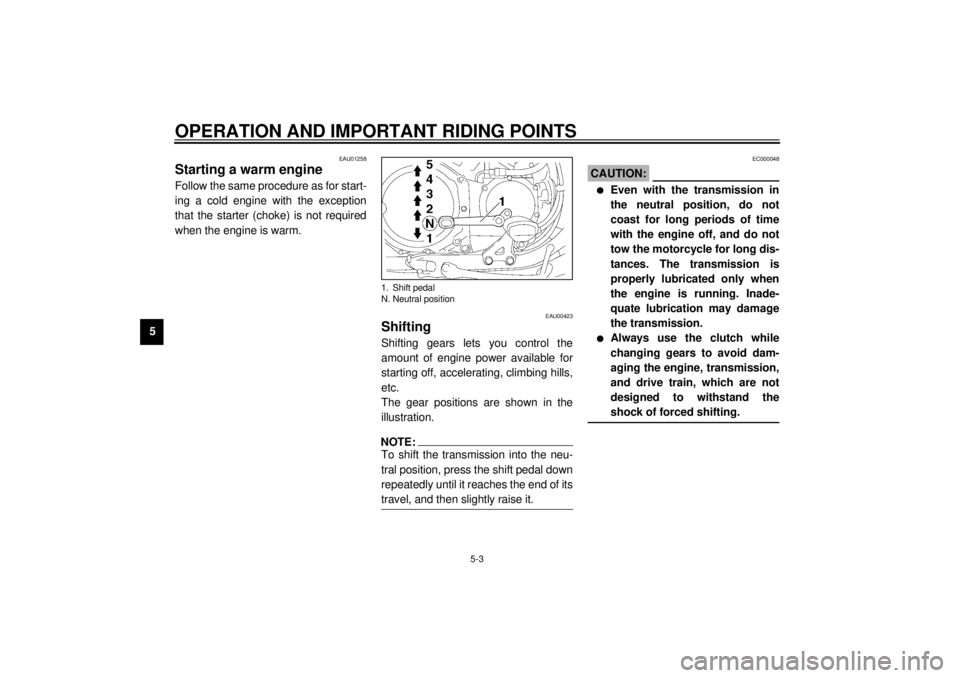
OPERATION AND IMPORTANT RIDING POINTS
5-3
5
EAU01258
Starting a warm engine Follow the same procedure as for start-
ing a cold engine with the exception
that the starter (choke) is not required
when the engine is warm.
EAU00423
Shifting Shifting gears lets you control the
amount of engine power available for
starting off, accelerating, climbing hills,
etc.
The gear positions are shown in the
illustration.NOTE:@ To shift the transmission into the neu-
tral position, press the shift pedal down
repeatedly until it reaches the end of its
travel, and then slightly raise it. @
EC000048
CAUTION:@ l
Even with the transmission in
the neutral position, do not
coast for long periods of time
with the engine off, and do not
tow the motorcycle for long dis-
tances. The transmission is
properly lubricated only when
the engine is running. Inade-
quate lubrication may damage
the transmission.
l
Always use the clutch while
changing gears to avoid dam-
aging the engine, transmission,
and drive train, which are not
designed to withstand the
shock of forced shifting.
@
1. Shift pedal
N. Neutral position
E_3lr.book Page 3 Wednesday, November 22, 2000 4:10 PM
Page 41 of 110

OPERATION AND IMPORTANT RIDING POINTS
5-4
5
EAU02941
Recommended shift points
(for Switzerland only) The recommended shift points during
acceleration are shown in the table be-
low.CF-01ENOTE:@ When shifting down two gears at a
time, reduce the speed accordingly
(e.g., down to 35 km/h when shifting
from 4th to 2nd gear). @
EAU00424
Tips for reducing fuel
consumption Fuel consumption depends largely on
your riding style. Consider the following
tips to reduce fuel consumption:l
Thoroughly warm up the engine.
l
Turn the starter (choke) off as
soon as possible.
l
Shift up swiftly, and avoid high en-
gine speeds during acceleration.
l
Do not rev the engine while shift-
ing down, and avoid high engine
speeds with no load on the engine.
l
Turn the engine off instead of let-
ting it idle for an extended length
of time (e.g., in traffic jams, at traf-
fic lights or at railroad crossings).
EAU00436
Engine break-in There is never a more important period
in the life of your engine than the period
between 0 and 1,000 km. For this rea-
son, you should read the following ma-
terial carefully.
Since the engine is brand new, do not
put an excessive load on it for the first
1,000 km. The various parts in the en-
gine wear and polish themselves to the
correct operating clearances. During
this period, prolonged full-throttle oper-
ation or any condition that might result
in engine overheating must be avoided.
Shift point
(km/h)
1st®2nd
2nd®3rd
3rd®4th
4th®5th23
36
50
60
E_3lr.book Page 4 Wednesday, November 22, 2000 4:10 PM
Page 42 of 110
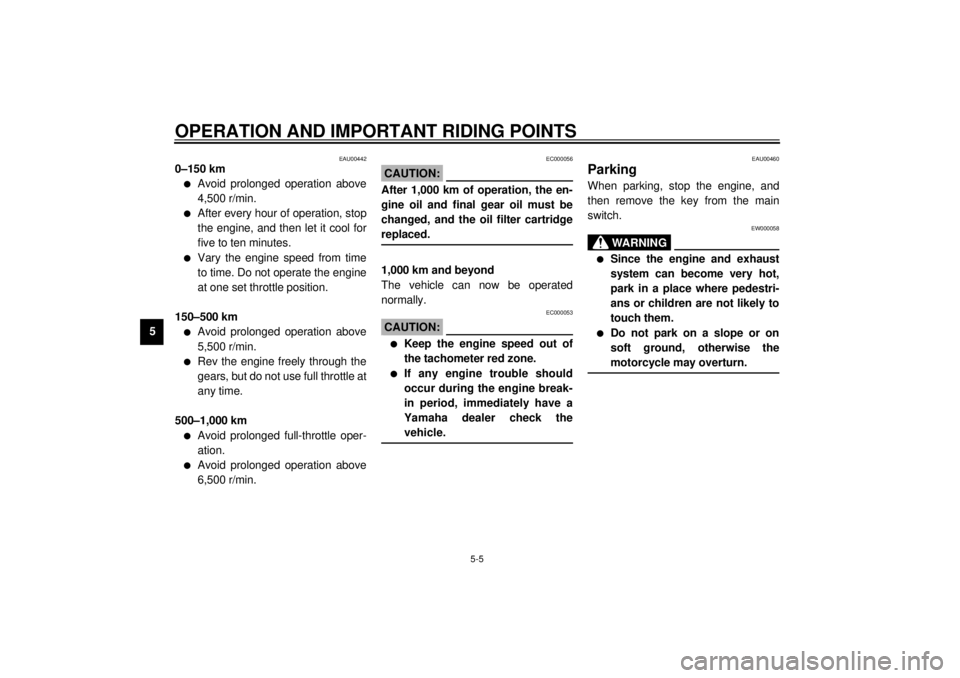
OPERATION AND IMPORTANT RIDING POINTS
5-5
5
EAU00442
0–150 kml
Avoid prolonged operation above
4,500 r/min.
l
After every hour of operation, stop
the engine, and then let it cool for
five to ten minutes.
l
Vary the engine speed from time
to time. Do not operate the engine
at one set throttle position.
150–500 km
l
Avoid prolonged operation above
5,500 r/min.
l
Rev the engine freely through the
gears, but do not use full throttle at
any time.
500–1,000 km
l
Avoid prolonged full-throttle oper-
ation.
l
Avoid prolonged operation above
6,500 r/min.
EC000056
CAUTION:@ After 1,000 km of operation, the en-
gine oil and final gear oil must be
changed, and the oil filter cartridge
replaced.@1,000 km and beyond
The vehicle can now be operated
normally.
EC000053
CAUTION:@ l
Keep the engine speed out of
the tachometer red zone.
l
If any engine trouble should
occur during the engine break-
in period, immediately have a
Yamaha dealer check the
vehicle.
@
EAU00460
Parking When parking, stop the engine, and
then remove the key from the main
switch.
EW000058
WARNING
@ l
Since the engine and exhaust
system can become very hot,
park in a place where pedestri-
ans or children are not likely to
touch them.
l
Do not park on a slope or on
soft ground, otherwise the
motorcycle may overturn.
@
E_3lr.book Page 5 Wednesday, November 22, 2000 4:10 PM
Page 43 of 110
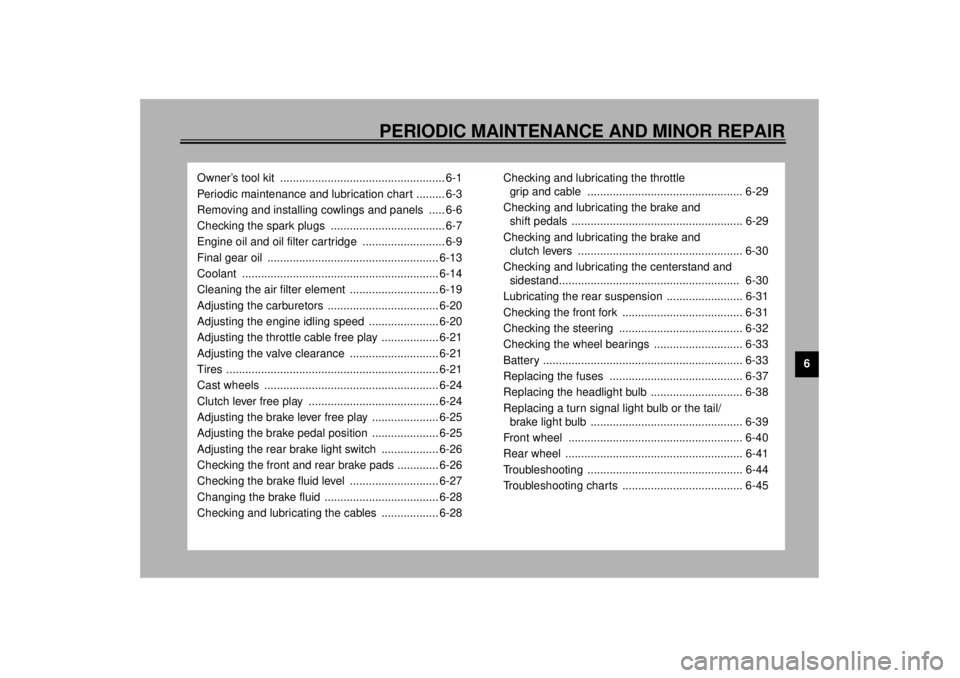
6
PERIODIC MAINTENANCE AND MINOR REPAIR
Owner’s tool kit .................................................... 6-1
Periodic maintenance and lubrication chart ......... 6-3
Removing and installing cowlings and panels ..... 6-6
Checking the spark plugs .................................... 6-7
Engine oil and oil filter cartridge .......................... 6-9
Final gear oil ...................................................... 6-13
Coolant .............................................................. 6-14
Cleaning the air filter element ............................ 6-19
Adjusting the carburetors ................................... 6-20
Adjusting the engine idling speed ...................... 6-20
Adjusting the throttle cable free play .................. 6-21
Adjusting the valve clearance ............................ 6-21
Tires ................................................................... 6-21
Cast wheels ....................................................... 6-24
Clutch lever free play ......................................... 6-24
Adjusting the brake lever free play ..................... 6-25
Adjusting the brake pedal position ..................... 6-25
Adjusting the rear brake light switch .................. 6-26
Checking the front and rear brake pads ............. 6-26
Checking the brake fluid level ............................ 6-27
Changing the brake fluid .................................... 6-28
Checking and lubricating the cables .................. 6-28Checking and lubricating the throttle
grip and cable ................................................. 6-29
Checking and lubricating the brake and
shift pedals ...................................................... 6-29
Checking and lubricating the brake and
clutch levers .................................................... 6-30
Checking and lubricating the centerstand and
sidestand......................................................... 6-30
Lubricating the rear suspension ........................ 6-31
Checking the front fork ...................................... 6-31
Checking the steering ....................................... 6-32
Checking the wheel bearings ............................ 6-33
Battery ............................................................... 6-33
Replacing the fuses .......................................... 6-37
Replacing the headlight bulb ............................. 6-38
Replacing a turn signal light bulb or the tail/
brake light bulb ................................................ 6-39
Front wheel ....................................................... 6-40
Rear wheel ........................................................ 6-41
Troubleshooting ................................................. 6-44
Troubleshooting charts ...................................... 6-45
E_3lr.book Page 1 Wednesday, November 22, 2000 4:10 PM
Page 47 of 110

PERIODIC MAINTENANCE AND MINOR REPAIR
6-4
6
10
*Brake hoses• Check for cracks or damage.ÖÖÖÖ Ö
• Replace. Every 4 years
11*Wheels• Check runout and for damage. ÖÖÖÖ
12*Tires• Check tread depth and for damage.
• Replace if necessary.
• Check air pressure.
• Correct if necessary.ÖÖÖÖ
13*Wheel bearings• Check bearings for looseness or damage. ÖÖÖÖ
14*Swingarm• Check swingarm pivoting point for play.ÖÖÖÖ
• Lubricate with molybdenum disulfide grease. Every 50,000 km
15*Steering bearings• Check bearing play and steering for roughness.ÖÖÖÖÖ
• Lubricate with lithium-soap-based grease. Every 50,000 km
16*Chassis fasteners• Make sure that all nuts, bolts and screws are properly
tightened.ÖÖÖÖ Ö
17 Sidestand/centerstand• Check operation.
• Lubricate.ÖÖÖÖ Ö
18*Sidestand switch• Check operation.ÖÖÖÖÖ Ö
19*Front fork• Check operation and for oil leakage.ÖÖÖÖ
20*Rear shock absorber
assemblies• Check operation and shock absorbers for oil leakage.ÖÖÖÖ
21*Carburetors• Check engine idling speed, synchronization and starter
operation.ÖÖÖÖÖ Ö
22 Engine oil• Change.ÖÖÖÖÖ Ö
23 Engine oil filter cartridge• Replace.ÖÖÖ
24*Cooling system• Check coolant level and vehicle for coolant leakage.ÖÖÖÖ Ö
• Change coolant. Every 3 years NO. ITEM CHECK OR MAINTENANCE JOBODOMETER READING (´1,000 km)
ANNUAL
CHECK
1 10203040
E_3lr.book Page 4 Wednesday, November 22, 2000 4:10 PM
Page 50 of 110

PERIODIC MAINTENANCE AND MINOR REPAIR
6-7
6
EAU03340
Panel A
To remove the panel1. Remove cowling A. (See page 6-6
for cowling removal and installa-
tion procedures.)
2. Remove the screws, and then take
the panel off.
To install the panel1. Place the panel in the original po-
sition, and then install the screws.
2. Install the cowling.
EAU01315
Panel B
To remove the panelRemove the screws, and then take the
panel off.
To install the panelPlace the panel in the original position,
and then install the screws.
EAU03329
Checking the spark plugs The spark plugs are important engine
components, which are easy to check.
Since heat and deposits will cause any
spark plug to slowly erode, the spark
plugs should be removed and checked
in accordance with the periodic mainte-
nance and lubrication chart. In addition,
the condition of the spark plugs can re-
veal the condition of the engine.
To remove a spark plug
1. Remove the spark plug cap.
1. Screw (´ 2)
1. Screw (´ 2)
1. Spark plug cap
E_3lr.book Page 7 Wednesday, November 22, 2000 4:10 PM